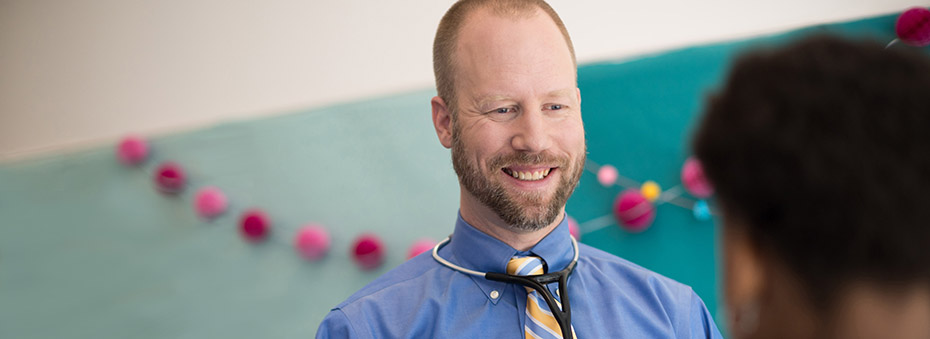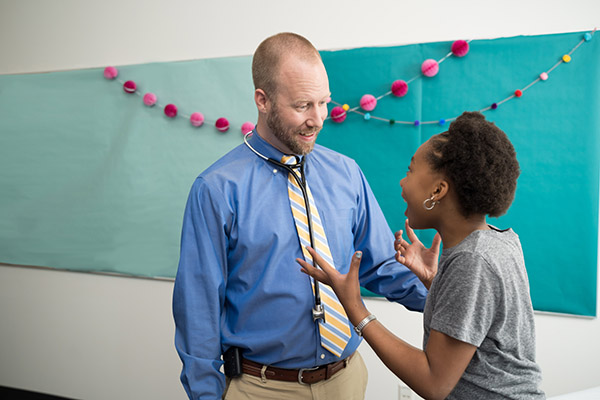Pediatric Pulmonary Hypertension Program

OHSU Doernbecher Children’s Hospital is the only children’s hospital in Oregon and southwest Washington with advanced care for children with pulmonary hypertension.
We offer:
- The region’s largest team of children’s heart and lung doctors working together to give your child expert care.
- Care from a team of two doctors, a nurse practitioner and a nurse who all specialize in pulmonary hypertension.
- The latest and most effective medications and treatments to ease your child’s symptoms.
- State-of-the-art technology for diagnosis and monitoring.
- Complete, team-based care in a child-friendly environment.
Understanding pulmonary hypertension in children
What is pulmonary hypertension?
Pulmonary hypertension is high blood pressure in the lungs. It is a serious condition that occurs when blood vessels in the lungs become stiff or narrow. The increased pressure forces the right side of the heart to work harder to pump blood through the lungs.
What causes pulmonary hypertension?
Pulmonary hypertension is rare in children. It can develop as a result of other conditions or on its own for unknown reasons. Some babies are born with it.
Causes include:
- Chronic lung disease
- A genetic or chromosomal disorder, such as Trisomy 21 (Down syndrome)
- Diseases that affect the entire body such as lupus and other rheumatic disorders
- A birth defect in the diaphragm (congenital diaphragmatic hernia)
Symptoms of pulmonary hypertension
Pulmonary hypertension symptoms can be similar to those of other heart and lung conditions. Some of the most common include:
- Shortness of breath
- Dizziness or fainting
- Fatigue
- Chest pain
- Racing pulse or heart palpitations
- Bluish or grayish lips or skin

What makes our program different
Doernbecher has the region’s only dedicated team with the expertise to manage pulmonary hypertension safely and effectively in children. Our team-based approach means we work with specialists throughout OHSU to give your child the best possible care.
Dr. Brendan Kelly leads the pediatric pulmonary hypertension team. He works closely with Dr. Patrick Evers, nurse practitioner Erika Rodakowski and nurse coordinator Sara LaBarge. The team sees babies, children and teens in our pulmonary hypertension clinic and in our pediatric and neonatal intensive care units.
Your child’s care team may also include:
- Children’s heart and lung doctors
- A nurse to coordinate your child’s tests, medications and care
- Physician associates and nurse practitioners
- Technologists
- Imaging specialists (radiologists)
- Heart catheterization specialists (cardiac interventionalists)
- Specialists in any related health conditions
- Critical care doctors (intensivists)
- Dietitians
- Pharmacists
- Social workers and child life specialists
Diagnosing pulmonary hypertension
We offer the most advanced tests to find conditions in your child’s heart, lungs and other organs that may contribute to high blood pressure in the lungs. Our early, accurate diagnosis can lead to more effective treatment.
Doernbecher’s labs and imaging rooms are designed to keep your child safe and comfortable. We coordinate all your child’s tests and schedule them on the same day when possible.
Tests may include:
- Echocardiogram
- Exercise stress testing
- Cardiac MRI (magnetic resonance imaging)
- Heart catheterization
- Electrocardiogram (ECG or EKG)
- CT (computed tomography) scan
- Genetic tests
- Blood tests and lab work
Treatment and monitoring
As a top-ranked children’s hospital, we have access to the latest research and treatment techniques.
- If your child’s pulmonary hypertension is the result of a medication or a health condition, we will work with your child’s entire care team to ease symptoms. High blood pressure in a child’s lungs often gets better as the other condition improves.
- If no cause is found (idiopathic pulmonary hypertension), medications and other treatments can slow the disease and manage your child’s symptoms.
Because this condition is complex, your child will need regular monitoring and follow-up care.
Your child’s treatments also may include:
Medication
This is often the first treatment. Medications can:
- Open and relax narrowed blood vessels
- Prevent blood clots
- Help the heart pump more blood more efficiently
- Eliminate excess fluid
Your care team may consider medicines that are given by mouth, injected under the skin, given through an IV or inhaled. Some require extra monitoring to make sure they are working safely. We also offer promising new therapies through clinical trials.
Oxygen therapy
Breathing extra oxygen helps increase oxygen in the blood and helps reduce lung blood pressure. Your doctor will talk with you about whether this will help your child.
Treatment for underlying conditions
We will work with our team of specialists to treat underlying conditions that could worsen pulmonary hypertension. They might include:
- Swallowing problems
- Chronic aspiration (food or liquid entering the airway)
- Breathing impaired by a sleep disorder
- Airway anomalies
- Clotting disorders
- Lung conditions
- Liver issues
- Structural heart issues
- Infection
- Inflammation
For families
Call 503-346-0640 to:
- Request an appointment.
- Seek a second opinion.
- Ask questions.
Locations
Parking is free for patients and their visitors.
Doernbecher Children’s Hospital
700 S.W. Campus Drive
Portland, OR 97239
Map and directions
Find other locations across Oregon and in southwest Washington.
Refer a patient
- Refer your patient to OHSU Doernbecher.
- Call 503-346-0644 to seek provider-to-provider advice.